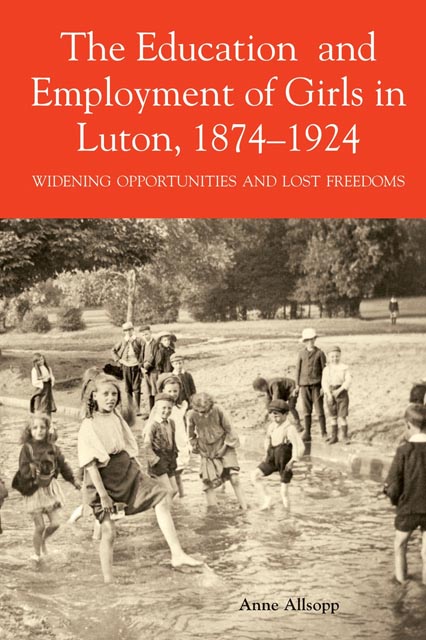Book contents
- Frontmatter
- Contents
- List of Illustrations
- List of Tables
- Dedication
- Acknowledgements
- Abbreviations
- Introduction
- Chapter One Luton: Scientiae et labori detur
- Chapter Two Further Perspectives Concerning Employment Patterns for Women
- Chapter Three Sunday Schools
- Chapter Four Education in the Time of the School Board
- Chapter Five Teaching: An Alternative Occupation
- Chapter Six Teacher Training and the Education of Students Aged Over Fourteen Under Bedfordshire County Council
- Chapter Seven Elementary Education 1903–1924
- Chapter Eight Rural Schools
- Chapter Nine Learning and Living
- Chapter Ten Secondary Education for Girls
- Conclusion
- Appendix
- Bibliography
- Index
Chapter Five - Teaching: An Alternative Occupation
Published online by Cambridge University Press: 03 August 2023
- Frontmatter
- Contents
- List of Illustrations
- List of Tables
- Dedication
- Acknowledgements
- Abbreviations
- Introduction
- Chapter One Luton: Scientiae et labori detur
- Chapter Two Further Perspectives Concerning Employment Patterns for Women
- Chapter Three Sunday Schools
- Chapter Four Education in the Time of the School Board
- Chapter Five Teaching: An Alternative Occupation
- Chapter Six Teacher Training and the Education of Students Aged Over Fourteen Under Bedfordshire County Council
- Chapter Seven Elementary Education 1903–1924
- Chapter Eight Rural Schools
- Chapter Nine Learning and Living
- Chapter Ten Secondary Education for Girls
- Conclusion
- Appendix
- Bibliography
- Index
Summary
In 1874, employment prospects for girls in Luton were based firmly in the straw industry and for the vast majority of the female population the ability to sew hats was all that was needed to secure an adequate income and maintain a family life. Another significant option, which was open to intelligent girls, was to become a pupil-teacher. It was probably not an easy choice when the enormous freedom which girls and women in the hat industry enjoyed was taken into account. Girls who entered teaching did not enjoy these freedoms for they had strict timetables and were under the control of the managers of their schools, according to the rules of their indentures. Hat girls had the freedom to work at home or to move from one factory to another but, with a few exceptions, they needed to stay in or around Luton to make a living. Teachers could, and did, move to other schools in the area and also to schools in other districts. School holidays may also have been an attraction, although the hat girls had their own holidays during the slack season.
Women in the hat industry socialized with each other, especially in shared workrooms, but teachers enjoyed a more exclusive social life, often in connection with professional associations. That teachers enjoyed each other's company cannot be denied and ‘teaching families’ were significant in the town. There is evidence to show that teachers had money to spend on foreign holidays and there were other advantages such as pension rights and tied accommodation. It is not easy to compare incomes because of the different types of salary scale, but it is true to say that experienced teachers did earn more than the average wage in the hat industry. In 1864 it was estimated that few women in the hat trade earned less than 10s a week and many would earn twice that amount. By 1876, adult hat sewers would be earning about 15s a week. Figures for the years 1890 to 1892 and 1917 to 1920 are more specific (see Tables 15a and 15b). Salaries of teachers are given as annual amounts while those of the hat workers are weekly, hourly or piece rate, thus indicating a difference in perceived status.
Opportunities to continue with their own studies must have appealed to some girls and others probably chose to teach from a sense of vocation.
- Type
- Chapter
- Information
- The Education and Employment of Girls in Luton, 1874-1924Widening Opportunities and Lost Freedoms, pp. 93 - 117Publisher: Boydell & BrewerFirst published in: 2023

